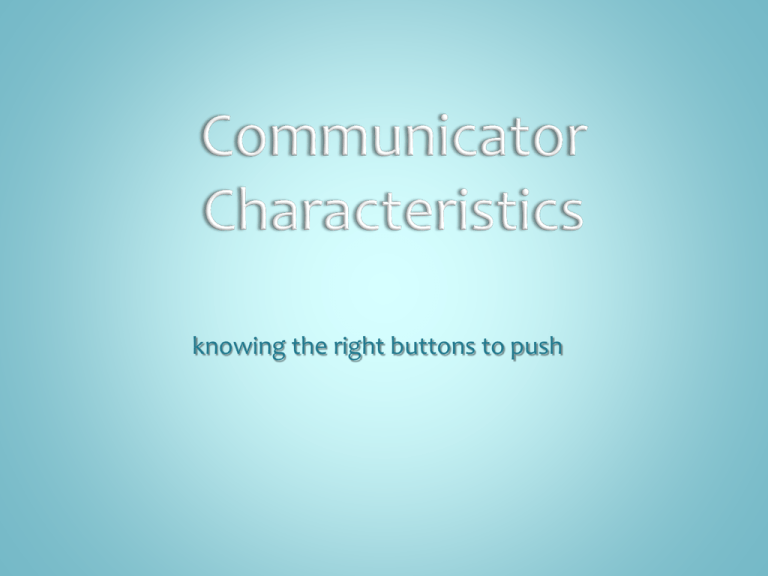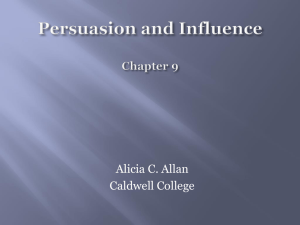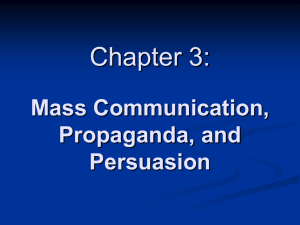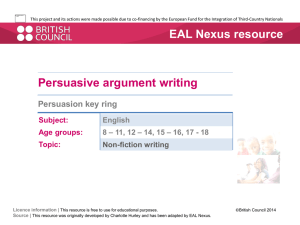Audience Analysis
advertisement

knowing the right buttons to push Age, Gender, Culture, Ethnicity 2 Children are easy marks. “young children — younger than 8 years — are cognitively and psychologically defenseless against advertising. They do not understand the notion of intent to sell and frequently accept advertising claims at face value” (American Academy of Pediatrics, cited by Strasberger, 2006) Persuaders target children. The average child in the U.S. sees 40,000 commercials per year. Junk food and obesity Alcohol and tobacco advertising Sexual messages on TV Internet predators 3 Age alone does not make people more gullible. Politeness reduces some seniors’ willingness to hang up or say no. Cognitive impairments make some seniors more vulnerable. Loneliness, isolation may make some seniors more vulnerable. Common scams targeting seniors Telemarketing scams Lottery and sweepstakes scams Fraudulent prizes Bank examiner cons 4 Gender stereotypes affect persuasion more than actual gender differences. Reinforcement Expectancy Theory Female MDs are expected to be more communal, nurturing. Male MDs are expected to be more assertive, leader-like. Individual differences matter more than gender differences. Women are as different from one another as from men. Goals, plans, and resources affect persuasion more than gender. Cross-Sex Effect Women are more easily persuaded by males, and vice versa. 5 Gender differences in persuasion tend to be overlapping, rather than “either-or.” All these females would be more assertive Than all these males Females Males For any given communication trait, such as assertiveness, the curves for females and males tend to be normal and overlapping. 6 Individualistic cultures value personal autonomy. Direct, assertive persuasion strategies Collectivistic cultures emphasize fitting in. Indirect, cooperative persuasion strategies 7 Less intelligent people are generally easier to persuade But… Less intelligent people may have more difficulty comprehending the message. Intelligence is not synonymous with knowledge or education on a topic. 8 Self-Esteem, Anxiety, Self-Monitoring, Ego-Involvement, Dogmatism & Authoritarianism, Cognitive Complexity & Need for Cognition, Argumentativeness and Verbal Aggressiveness 9 The Trade-off between low and high esteem Low esteem: more likely to yield, but less likely to follow through. High esteem: less likely to yield, but more likely to follow through. People with moderate esteem may be the most persuadable. Images courtesy of www.aperfectworld.org http://aperfectworld.org/emotions.htm 10 high anxiety may increase perceived vulnerability, but… high anxiety may also trigger avoidance or panic. Image courtesy of www.aperfectworld.org http://aperfectworld.org/emotions .htm 11 High self-monitors are: More adaptable, sensitive to social cues More responsive to imageoriented ads Low self-monitors are: More independent, less conforming More responsive to product features and functions Image courtesy of www.aperfectworld.org http://aperfectworld.org/emoti ons.htm 12 Ego involved people tend to have: Assimilation: a message is perceived as being closer to Smaller latitudes of one’s own position. acceptance Contrast: a message is Wider latitudes of rejection perceived as being farther More ego involved from one’s own position. people tend to have narrower views. 13 Naomi is mildly Naomi’s attitude large latitude of ego-involved on the acceptance issue of abortion. Loretta is highly ego-involved on the issue of abortion. small latitude of rejection Loretta’s attitude small latitude of acceptance large latitude of rejection 14 According to the ELM, a person with high issue involvement: will rely on central processing will be more responsive to good arguments and evidence. A person with low issue involvement: will favor peripheral processing. will look for mental shortcuts, heuristic cues 15 Authoritarian personalities are close-minded and conservative. Dogmatism is a broader construct. Dogmatic people may be conservative or liberal. Dogmatic people engage in rigid, doctrinaire thinking. Dogmatic people are more persuadable by authority figures. “Dogmatism—not religious fundamentalism, terrorism, or fanaticism in general—is the greatest threat to social, political, and scientific progress” (Johnson, 2009) 16 “High” dogs: Prefer clear-cut rules and order. Like status hierarchies. Respect authority figures View the world in black or white. “Only if someone I respect says so…” Image courtesy of www.aperfectworld.org http://aperfectworld.org/emotions.htm “Low” dogs: Prefer fewer rules, more flexibility. Place less emphasis on status and hierarchy. Are less obedient to authority. View the world in shades of gray. 17 Need for cognition is the desire to think about, reflect on things. Cognitive complexity involves the number of constructs people use when thinking. Cognitively complex (as opposed to cognitively simple) people: are better at perspective taking are more likely to use central processing can tolerate more inconsistency 18 Verbal aggressiveness: Is a destructive trait. Involves attacking another’s self concept. High aggressives: Engage in name calling, put downs, threats. Argumentativeness: Is a constructive trait. High argumentatives: Focus on the issue, not on personalities. Edit their arguments before making them. 19 Audience adaptation is key to successful persuasion The message must be tailored to the listener’s frame of references Effective persuasion is: Audience-centered Market-driven Listener-oriented 20







